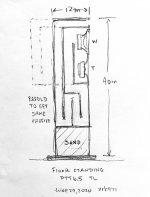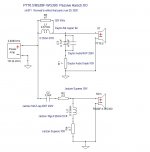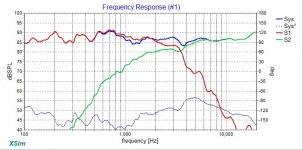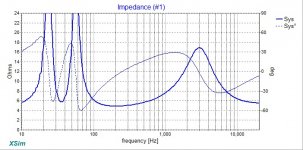Bill,
These speakers are quite compact... probably you shall have an easier time convincing SWMBO... 😀
If you are serious, I am sure someone can be found who would be willing to help you with the cabinet. 🙂
These speakers are quite compact... probably you shall have an easier time convincing SWMBO... 😀
If you are serious, I am sure someone can be found who would be willing to help you with the cabinet. 🙂
Let's just say the baffle is cut for 6.5" but the 0.6cuft cabinet on the back is not the finest bit of design but is of the sort of dimensions that would fit a TL in. XRKs solution is too deep for the compromised space of listening room, living room and playroom.
PMC does use eggcrate foam internally on the walls (same as me). I also add fiberglass or polyfill stuffing in the closed end up to the bass driver. I noticed adding a very small amount of loose polyfill stuffing in the vent makes the bass a little drier. PMC usually has a piece of black aquarium fish filter foam there - and it probably has an effect on the sound. Very easy to adjust and probably reduces potential mice/insect visitors from making a nest inside the fine long channels.
Here is a review with measurements of the Twenty 24. The tweeter has quite a big dip and bump. I don’t know what that’s all about. The polars are similar to what Maty posted. They fall way off when off axis.
https://pmc-speakers.com/sites/default/files/attachments/HiFi Critic twenty 24 review.pdf
@billshurv
Perhaps of this was reformatted as a tall floorstander than only half as deep?
Here is a review with measurements of the Twenty 24. The tweeter has quite a big dip and bump. I don’t know what that’s all about. The polars are similar to what Maty posted. They fall way off when off axis.
https://pmc-speakers.com/sites/default/files/attachments/HiFi Critic twenty 24 review.pdf
@billshurv
XRKs solution is too deep for the compromised space of listening room, living room and playroom.
Perhaps of this was reformatted as a tall floorstander than only half as deep?
Last edited:
@billshurv
Perhaps of this was reformatted as a tall floorstander than only half as deep?
Then it would work and I might be persuaded to fall out of love with my Apogees. Maybe...
XRKs solution is too deep for the compromised space of listening room, living room and playroom.
I had a look at this keeping the line length the same and the entry/exit of the line the same area, may give you some ideas -
Simple Passive Harsch XO Using PTT6.5 and RS28F in a Waveguide
Dang, those measurements are really hard to beat.BTW, yours and KEF Q100 (measured by Zvu). And I no longer rave on the thread.
I’ll let you work out the details, but I think something like this gives the correct pleasing aspect ratio, keeps the vent at the same spot on top, and provides room to adjust the folding to keep a similar taper ratio. The sand ballast at the bottom improves stability and reduces vibrations too.
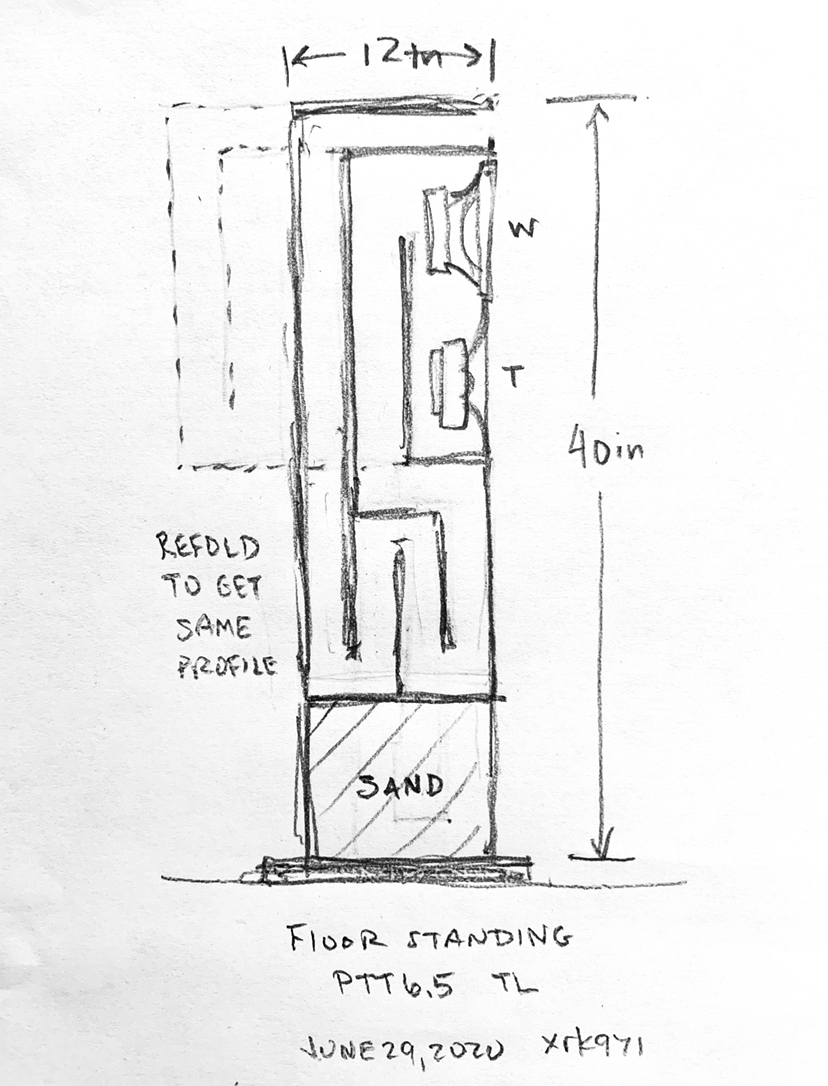
Attachments
One thing to keep in mind with the PPT6.5 in a TL is that it sounds like a much bigger speaker in capability. Closer to a 8in woofer given similar stroke x Sd and in a smaller package. The distortion levels are amazingly low with the TL vs a passive radiator, also no mid range leakage out of the passive radiators.
Still in listening phase for a week or so to form good impression for evaluation before being biased by measurements. Also, timing wise - too buy with other work to do any serious analysis yet so will have to await at least until this coming weekend. Subjectively, the speakers sound great and punch well beyond any 6.5in driver speaker ever would. I am really enjoying the sound of a soft dome tweeter in a waveguide. I am surprised that a 3.5kHz crossover works so well here. I normally prefer domes crossed circa 1.7kHz to 2kHz. In this case, the integration with the PTT6.5 at 3.5kHz sounds so natural and smooth you can't tell where the XO is.
Remind me again your listening distance?Still in listening phase for a week or so to form good impression for evaluation before being biased by measurements. Also, timing wise - too buy with other work to do any serious analysis yet so will have to await at least until this coming weekend. Subjectively, the speakers sound great and punch well beyond any 6.5in driver speaker ever would. I am really enjoying the sound of a soft dome tweeter in a waveguide. I am surprised that a 3.5kHz crossover works so well here. I normally prefer domes crossed circa 1.7kHz to 2kHz. In this case, the integration with the PTT6.5 at 3.5kHz sounds so natural and smooth you can't tell where the XO is.
One thing to keep in mind with the PPT6.5 in a TL is that it sounds like a much bigger speaker in capability. Closer to a 8in woofer given similar stroke x Sd and in a smaller package.
If I told the wife I didn't need the sub any more she'd be very happy 🙂 (it's a small room)
Remind me again your listening distance?
Typically 2m to 3m.
Hi xrk971
Thanks for the inspiring thread!
I'm trying to follow and is building of a version with Bliesma T34A as tweeter. I will make a baffle with 18-20mm offset for the tweeter. No waveguide.

Pretty much identical internal measures and front (2cm wider) so the crossover for Purifi should be sufficient I guess.
How important is the DCR of the coil (0,68mH and 0,54ohm)? Quite high resistance for an inductor?!
I read your comment "it's all in the impedance measurement". What do you mean? Is it the low end impedance peaks you want to tweak (decrease), or are you mainly looking for box resonance in the curves?
Thanks
Thanks for the inspiring thread!
I'm trying to follow and is building of a version with Bliesma T34A as tweeter. I will make a baffle with 18-20mm offset for the tweeter. No waveguide.

Pretty much identical internal measures and front (2cm wider) so the crossover for Purifi should be sufficient I guess.
How important is the DCR of the coil (0,68mH and 0,54ohm)? Quite high resistance for an inductor?!
I read your comment "it's all in the impedance measurement". What do you mean? Is it the low end impedance peaks you want to tweak (decrease), or are you mainly looking for box resonance in the curves?
Thanks
Hi Deerhunt!
Very cool to see others trying this out! You have a premium T34A tweeter there - I am not sure if it will be the same crossover - only way to know for sure is to measure the response and model in Xsim. I don't think it is going to hurt to try it as is and see how it works vs the RS28F. Is the Bliesema 4ohms?
Regarding my inductor - 0.68mH and 0.54ohm is the temporary one, I used a 0.33ohm flat copper foil in the final inductor. If you have a lower value, it will increase sensitivity of PTT6.5 and compensate by using higher resistance on tweeter.
2cm added to baffle is not too much, but will not be same as 21.6cm wide nominal one I have. The waveguide is closer to a 5cm offset, so it might be tricky to get the same Harsch XO. I think someone mentioned an off the shelf waveguide somewhere that can be adapted to the Bliesema once the mesh grille is removed.
What I mean is that after the speaker is built, use a DATS or similar device and do an impedance sweep of the TL. You will see two peaks typical of a vented cabinet. The dip in between the two peaks shows the cabinet tuning frequency - about 30Hz or so. The two peaks on either side will be high without any damping (fiberglass or polyfill in the chamber from closed end to the first turn). Add a small wad of polyfill loosely pulled apart in this rear chamber and you will see the height of the impedance peaks drop and the height of the dip in between climb. Add enough to make the impedance look like a cat's head with two ears (maybe longer ears like a caracal). The shorter the ears, the drier the bass will be - tight and low group delay, but at the expense of bass extension and bass SPL sensitivity. The taller the ears and the looser and more bass reflex sloppy sounding like it will be. Although never as bad as a pure reflex cabinet because all those turns naturally provide aeroacoustic damping. The other place to play with damping is to add a piece of very porous reticulated open cell foam like used in fish aquarium external flow filters. Pores are circa 1mm to 2mm (not the dense stuff) to the final vent terminus. Another place to play with damping and it is very very sensitive is to add a very light wisp of damping polyfill loosely teased out (maybe 2 grams) worth in the final vertical channels at the back - accessible through the speaker terminal binding post cup. That will really flatten those cat ears on the impedance sweep. So do changes slowly and listen and measure. Pick what sounds best. Some people will used these near a back wall and have loads of room bass reinforcement - in which case, more aquarium foam on the exit helps to control room boominess.
Here is the impedance sweep from my RS225 TL for the 10F/RS225 FAST speaker. It is much bigger but shows you the power of this diagmostic:
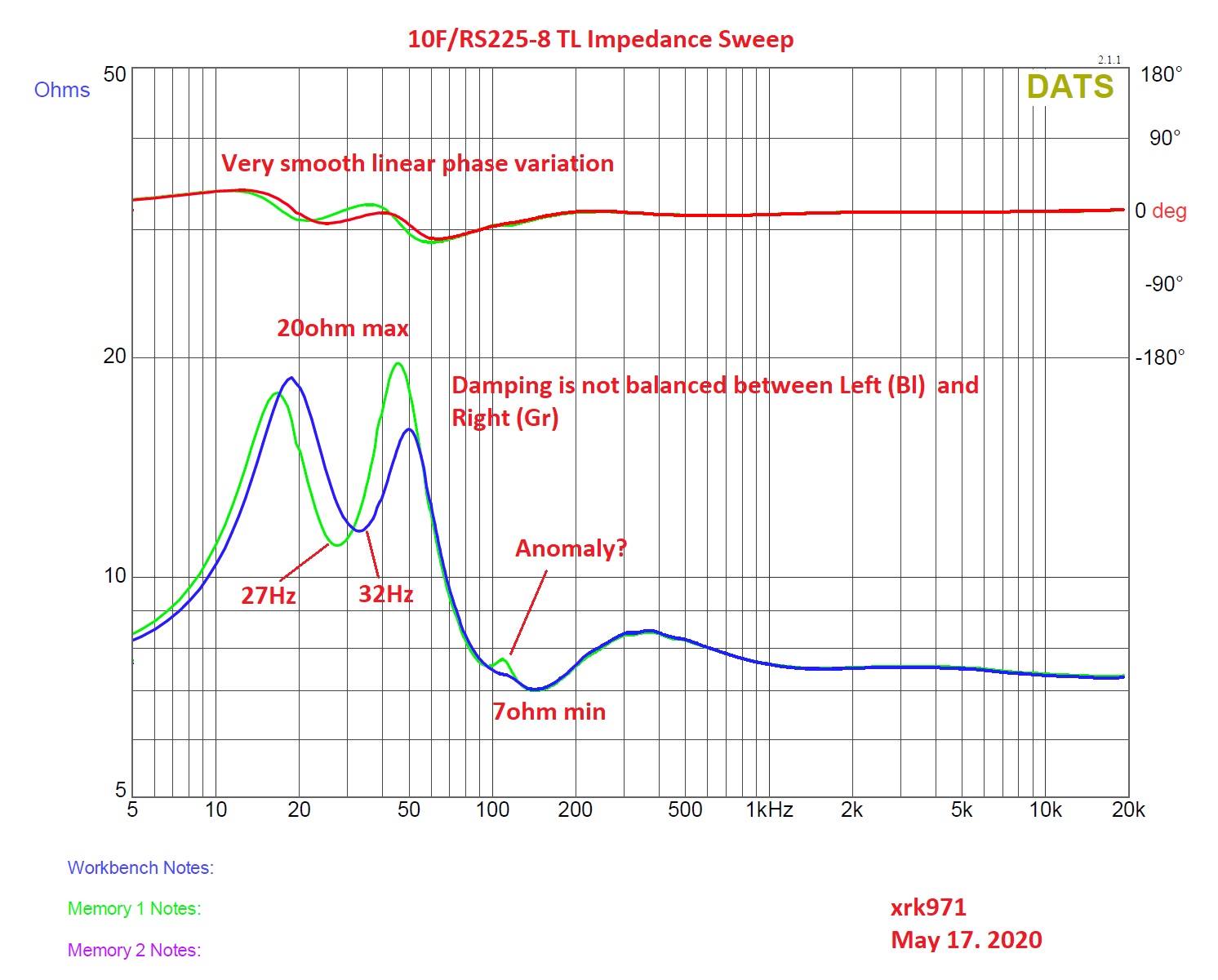
Very cool to see others trying this out! You have a premium T34A tweeter there - I am not sure if it will be the same crossover - only way to know for sure is to measure the response and model in Xsim. I don't think it is going to hurt to try it as is and see how it works vs the RS28F. Is the Bliesema 4ohms?
Regarding my inductor - 0.68mH and 0.54ohm is the temporary one, I used a 0.33ohm flat copper foil in the final inductor. If you have a lower value, it will increase sensitivity of PTT6.5 and compensate by using higher resistance on tweeter.
2cm added to baffle is not too much, but will not be same as 21.6cm wide nominal one I have. The waveguide is closer to a 5cm offset, so it might be tricky to get the same Harsch XO. I think someone mentioned an off the shelf waveguide somewhere that can be adapted to the Bliesema once the mesh grille is removed.
I read your comment "it's all in the impedance measurement". What do you mean? Is it the low end impedance peaks you want to tweak (decrease), or are you mainly looking for box resonance in the curves?
What I mean is that after the speaker is built, use a DATS or similar device and do an impedance sweep of the TL. You will see two peaks typical of a vented cabinet. The dip in between the two peaks shows the cabinet tuning frequency - about 30Hz or so. The two peaks on either side will be high without any damping (fiberglass or polyfill in the chamber from closed end to the first turn). Add a small wad of polyfill loosely pulled apart in this rear chamber and you will see the height of the impedance peaks drop and the height of the dip in between climb. Add enough to make the impedance look like a cat's head with two ears (maybe longer ears like a caracal). The shorter the ears, the drier the bass will be - tight and low group delay, but at the expense of bass extension and bass SPL sensitivity. The taller the ears and the looser and more bass reflex sloppy sounding like it will be. Although never as bad as a pure reflex cabinet because all those turns naturally provide aeroacoustic damping. The other place to play with damping is to add a piece of very porous reticulated open cell foam like used in fish aquarium external flow filters. Pores are circa 1mm to 2mm (not the dense stuff) to the final vent terminus. Another place to play with damping and it is very very sensitive is to add a very light wisp of damping polyfill loosely teased out (maybe 2 grams) worth in the final vertical channels at the back - accessible through the speaker terminal binding post cup. That will really flatten those cat ears on the impedance sweep. So do changes slowly and listen and measure. Pick what sounds best. Some people will used these near a back wall and have loads of room bass reinforcement - in which case, more aquarium foam on the exit helps to control room boominess.
Here is the impedance sweep from my RS225 TL for the 10F/RS225 FAST speaker. It is much bigger but shows you the power of this diagmostic:
Last edited:
I should have posted my final as-built crossover as shown in the photo.

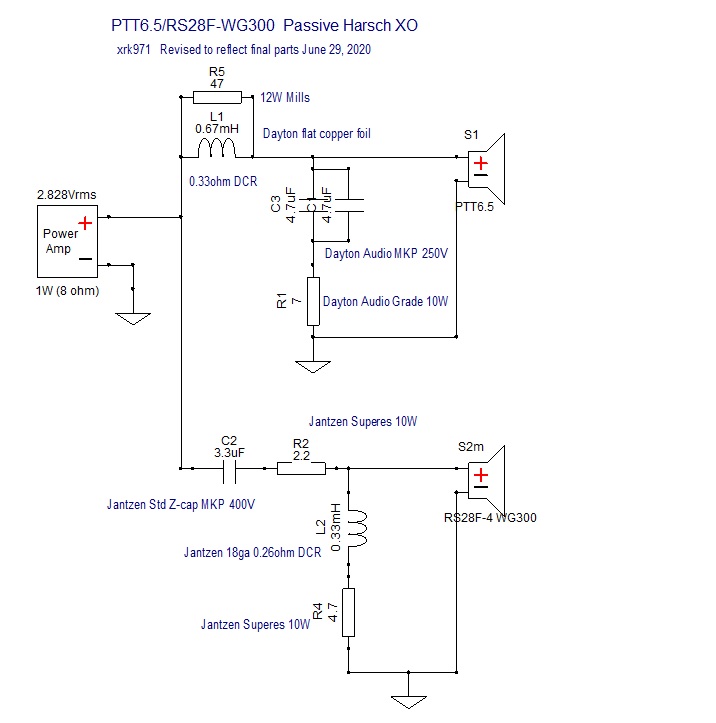
Here is the associated predicted frequency and phase:
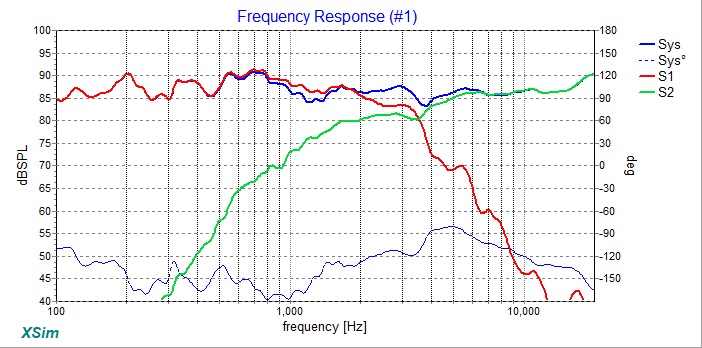
Here is the associated predicted impedance:
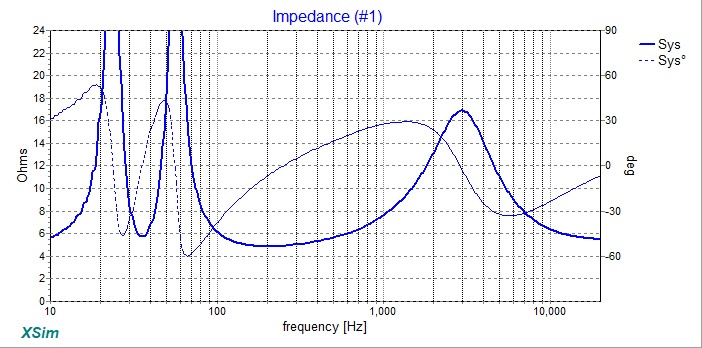
Here is the associated predicted frequency and phase:
Here is the associated predicted impedance:
Attachments
- Home
- Loudspeakers
- Multi-Way
- Simple Passive Harsch XO Using PTT6.5 and RS28F in a Waveguide
